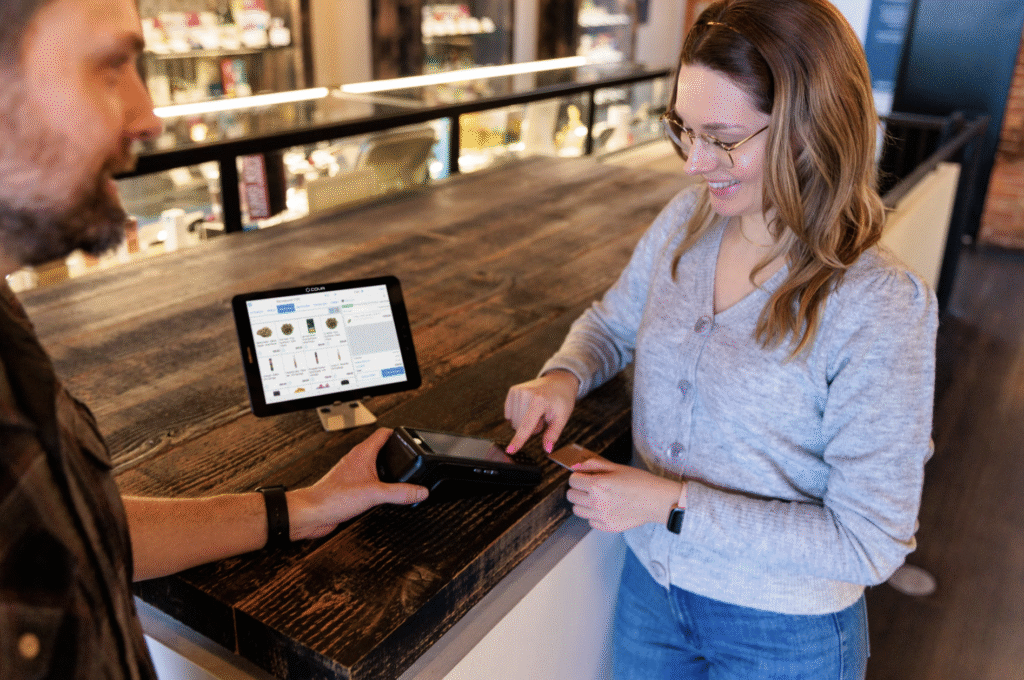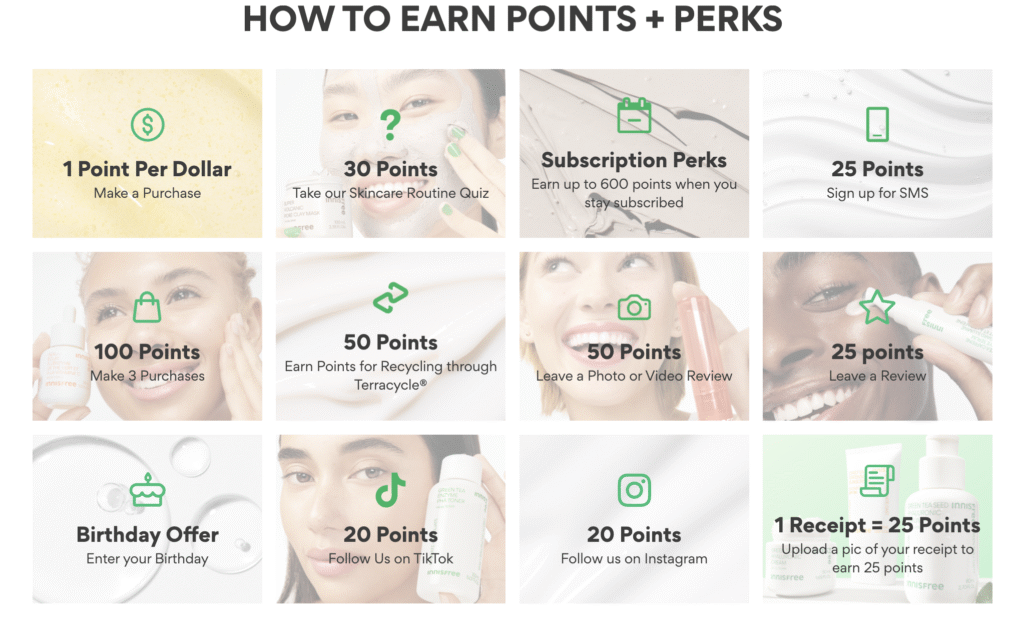Estimated Reading Time: 10 minutes

Loyalty in retail has evolved and there’s no going back, unless you’ve invented a time machine—in which case, congrats.
In 2025, retail omnichannel loyalty is the name of the game. From mobile apps and eCommerce platforms to in-store experiences and social media, customers now expect loyalty programs that follow them everywhere—literally.
Here’s the kicker: A study highlights that 73% of consumers use multiple channels during their shopping experience. But the good news is that you don’t have to be a massive global brand to make it work.
This article breaks down what retail omnichannel loyalty means and how real retail brands are using omnichannel loyalty, with case studies from brands like Sephora and Innisfree. If you’re looking for retail omnichannel examples that actually make an impact on your business, you’re in the right place.
- What is Retail Omnichannel Loyalty?
- How Omnichannel Loyalty Works in Retail
- Omnichannel Loyalty Case Studies: How Top Retail Brands Do It
- 4 Reasons More Retailers Are Going Omnichannel in 2025
- How to Start Your Own Retail Omnichannel Loyalty Program
- Best Practices for Building a Loyalty Program That Works Across Channels
- Retail Omnichannel Loyalty FAQs: What Businesses Ask Most
- Conclusion: Why You Need to Act Now
What is Retail Omnichannel Loyalty?
Let’s keep it simple: Retail omnichannel loyalty is when your loyalty program works across every touchpoint. Whether it’s online, offline, email, or mobile, it connects all the dots in your customer’s journey and gives them a rewarding experience no matter how or where they shop.
There’s a stark difference between retail omnichannel loyalty and the traditional multichannel loyalty structure, where each platform works in silos. In other words, each channel (website, app, or physical store) operates independently without sharing data.
But what does this mean for your customers and your business?
For your customers, this results in a fragmented experience. They might earn points from an online purchase, but are unable to redeem them in-store (or vice versa). Worse, they may even need to manage separate accounts or loyalty IDs for each platform. Not fun.
As for your business, the problem runs deeper. Without a connected system, the same customer may appear as two separate users—one online and one offline. This makes it impossible to get a 360-degree view of their behavior and preferences. You lose out on valuable insights, such as which products they browse online before purchasing in-store, or how frequently they shop across different platforms.
However, with a proper omnichannel system in place, everything is synced. This enables smoother redemptions, better personalization, and a loyalty experience that feels effortless.
Here’s what that might look like:
- A customer browses online
- Adds items to cart via mobile
- Picks up in-store
- Earns and redeems points across every channel
Think about it. Unlike traditional multichannel loyalty (which often operates in silos), omnichannel retailing syncs everything together, making the customer experience frictionless and familiar.
How Omnichannel Loyalty Works in Retail
To make omnichannel loyalty function effectively, brands integrate:
POS + eCommerce synchronization
When your point-of-sale (POS) system talks to your online store, you automatically create a unified transaction history. This allows customers to earn points, see rewards, and receive tailored offers (no matter where they shop).
Loyalty platforms & CRM
Smart loyalty software plugs into your customer relationship management (CRM) and captures behavior across all touchpoints—just like SimpleLoyalty’s breakdown in How to Implement an Omnichannel Loyalty Program for Retailers. This data helps you automate triggers like unused rewards or birthday discounts.
Mobile app integration
Apps are crucial in 2025. They’re where customers track points, receive push offers, and access exclusive perks—all synched to their account.
Omnichannel Loyalty Case Studies: How Top Retail Brands Do It
Let’s dissect how real brands are making this work. These retail omnichannel case studies show that loyalty isn’t just about discounts anymore—it’s about creating consistent experiences that customers want to run back to.
Sephora Beauty Insider
Sephora’s Beauty Insider program is one of the best-known retail omnichannel examples out there. Why? Because it delivers a consistent, personalized experience across their app, website, and in-store.
Here’s how they do it:
- Members earn points whether they buy online or in-store
- Personalized product suggestions based on browsing and purchasing behavior
- In-app access to offers, event invites, and members-only content
- Seamless use of points and perks at checkout, online, or offline
- Customers are encouraged to provide more personal details in exchange for additional points. For instance, their skin type, beauty preferences, and product concerns can all be ‘traded’ for points. This data helps Sephora recommend better-suited products and send more relevant offers while simultaneously deepening customer engagement.
The program is also tiered under Sephora’s Beauty Pass with White, Black, and Gold tiers. Each tier unlocks escalating perks based on yearly spend. This includes birthday gifts, early access to sales, and private sales. These tiers further incentivize customers to engage across multiple platforms to climb the ladder.

Sephora Beauty Rewards Pass (Image retrieved from Sephora MY webpage)
Their omnichannel loyalty strategy isn’t just about rewards, but more about relevance. And it’s working. It feels like they read your mind…or at least your browsing history. This is the reason why Sephora’s loyalty members spend more, return more often, and engage more deeply with the brand.
Nike Membership
Nike’s loyalty program can be described as a full-blown ecosystem that goes far beyond purchases. Their omnichannel retail strategy connects physical stores, online shopping, and fitness apps through one unified Nike Membership account.
What they do right:
- Exclusive product drops and early access online
- Store-specific rewards based on your location
- Personalized style tips and workout content
- Integration with Nike Run Club and Training Club apps, allowing users to earn rewards for workouts, challenges, and fitness milestones. This drives both brand engagement and product relevance. For example, promoting shoes and apparel based on workout behavior.

Nike Run Club (Image retrieved from Nike Run Club webpage)
One can argue that this is an omnichannel loyalty program at its very best. Nike isn’t just playing the loyalty game, they’re hosting it, coaching it, and winning gold medals. One membership, endless touchpoints. It’s a major reason Nike maintains strong customer retention and keeps customers coming back for more.
Innisfree
Innisfree Rewards may not be as massive as Nike Membership. Nonetheless, they’ve nailed it in their own way. Their omnichannel loyalty program ties together online and in-store data to create one smooth experience.
Here’s what they do right:
- Points are synced across their website and physical stores
- Customers get app alerts for in-store events or upcoming offers
- Purchases trigger personalized emails and product care tips
- Gamified challenges and birthday perks keep engagement high

Innisfree Rewards (Image retrieved from Innisfree webpage)
After streamlining their loyalty program into one seamless ecosystem across platforms, this resulted in more repeat purchases and a retail omnichannel strategy that feels genuine (not overwhelming).
4 Reasons More Retailers Are Going Omnichannel in 2025
Still on the fence about building your own retail omnichannel loyalty program? Here’s why it works, and why it’s becoming the standard in 2025:
1. Seamless customer experience
Customers want ease. Omnichannel loyalty lets them earn and engage with your brand anytime and anywhere. They don’t want to remember three passwords or explain to a cashier why their online points don’t work. Just one smooth experience that encourages conversions.
Example: A shopper adds an item to their cart on your app, walks into your store, and checks out using their loyalty points. Smooth.
2. Better personalization
With an omnichannel retail loyalty program in place, you collect richer data across platforms—unlocking targeted offers and meaningful messaging. That means better targeting and content that actually resonates with your audience. From browsing behavior to purchase history, you’ll be able to find out what your customers really want and serve up rewards they’ll care about. Explore 5 benefits of omnichannel loyalty programs for small businesses for practical examples.
Example: A customer who frequently buys skincare products online gets a push notification for an in-store consultation and exclusive skincare kit, tailored specifically for them.
3. Higher retention and repeat purchases
Customers engaging across multiple channels show roughly 30% higher lifetime value and businesses with omnichannel strategies retain around 89% of their customers. This proves that when you add omnichannel functionality, that number increases even more. Why? Because the experience is convenient and rewarding across every channel.
Example: A customer who shops in-store monthly starts using the app for flash sales and reordering favorites. This doubles their purchase frequency within months.
4. Stronger emotional connection
This is the secret sauce. When your loyalty program remembers customers and rewards them—no matter where they interact, you build brand trust and long-term loyalty, even when competitors offer discounts.
Example: A shopper receives a birthday reward and a “thank you” message in-store after checking out. This reinforces a brand relationship that feels human and personal.
How to Start Your Own Retail Omnichannel Loyalty Program
Think you need a massive budget or an enterprise team to pull this off? Think again. Many loyalty platforms today are built for small and mid-sized retailers.
Here’s a simple plan your small-sized retail store can start with omnichannel loyalty:
- Start with a clear goal: Are you looking to boost repeat purchases or increase store visits? Clear goals help shape the right strategy and features.
- Choose a platform: Look for one that integrates with your POS and online store. Platforms like SimpleLoyalty make this easy for growing retailers.
- Set consistent earning and redemption rules: Make it easy to earn and redeem points. Whether a customer buys online or in-store, they should be able to earn points the same way to reduce friction and confusion.
- Automate key loyalty touchpoints: Set up email or trigger rewards for birthdays, inactivity, or point milestones. Automation saves time and keeps customers engaged.
- Track your metrics: Monitor which channels bring in the most redemptions, signups, or repeat visits. Use this data to optimize your program and maximize return on investment (ROI).
- Start small, then scale: Keep in mind that you don’t have to go big right away. Think of it like planting a loyalty seed, not launching a full-blown jungle on Day 1. Begin with basic integrations and expand as you learn what works best for your customers.
Best Practices for Building a Loyalty Program That Works Across Channels
Aspire to be more like Nike and less like the dusty punch card under your customer’s fridge magnet? Here are three retail loyalty best practices:
Sync All Channels
Make sure your POS, eCommerce, CRM, and loyalty system are all connected. If the data is fragmented, it’s costing you sales.
Example: A customer earns points in-store but can’t see their balance online due to disconnected systems which leads to confusion and drop-off.
Personalize Everything
Instead of sending out generic messages, you can opt to send smarter offers such as product recommendations, birthday rewards, and reminders tailored to individual shopping habits.
Example: A shopper who always buys eco-friendly products receives curated rewards and promotions for sustainable items only.
Reward Consistency
Offer discounts for actions like writing reviews or sharing on social media. It deepens engagement beyond purchases.
Example: A customer earns extra points for tagging the brand in an Instagram story about their latest purchase.
Retail Omnichannel Loyalty FAQs: What Businesses Ask Most
Can I run an omnichannel loyalty program without offering discounts?
Of course! Discounts are just one type of reward. Many successful programs offer early drops or exclusive access which can be more powerful than slashing prices, especially for premium or niche brands.
Will omnichannel loyalty overwhelm my customers with too many touchpoints?
Not if done right. The goal is to be consistently relevant where your customer already is.
How do I encourage my customers to use all my channels (and not just one)?
Incentivize it! You have the opportunity to curate incentives for your customers, such as:
- Offering bonus points when they shop through a new channel
- Encouraging behavior like ‘click-and-collect’ or ‘buy online’
- Run channel-exclusive perks such as app-only promotions or in-store scratch cards
Conclusion: Why You Need to Act Now
In 2025, loyalty isn’t locked to one channel, it follows your customers everywhere they go. That’s what omnichannel loyalty does best. And no, you don’t need to be a billion dollar brand to do it well. Shoppers expect a seamless, personalized experience across every platform, and if you’re not delivering it, someone else will.
When you do, you won’t just win their wallets, you’ll earn their loyalty too. And let’s be real, loyalty is harder to earn than a like on an Instagram Reel these days. But when you nail it? Chef’s kiss. Because in today’s retail landscape, brands that adapt fastest are the ones customers remember.
Want to create a loyalty experience your customers will love? Check out How to Implement an Omnichannel Loyalty Program for Retailers—then take the first step before your competitors beat you to it!

